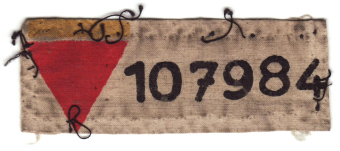The Story “Tattoo Number 107,907” by John Hersey (1963)

© United States Holocaust Memorial Museum (Wollheim papers)
The American writer and journalist John Hersey compiled a number of journalistic pieces in a volume called Here to Stay, published in 1963. Most of these stories resulted from his encounters as a war correspondent during World War II in both major theaters, Pacific and European, and had already appeared in the late 1940s in The New Yorker or Life. Only two were published here for the first time: “Tattoo Number 107,907”—an account of the survival of Norbert Wollheim, here called “Alfred Stirner”—and the short story “Not to Go with the Others,” about a Polish prisoner who narrowly escapes death at the hands of the SS in Poland in the last days of the war.
Common to all nine stories in Here to Stay is the fact that they depict people in catastrophic, life-threatening situations, which they manage to survive—though barely—by dint of their moral tenacity and strength of will. The stories’ range of topics includes the rescue of an old woman from a flood-swollen river, the flight of a Hungarian family to Austria in 1956, the return of wounded US soldiers from World War II and their physical and emotional problems, the near loss of John F. Kennedy with the patrol boat he was commmanding off the Solomon Islands in the fight against Japan, and the tale of six people who survive the dropping of the atomic bomb on Hiroshima, but lose loved ones and suffer from the effects of radiation illness themselves. “Hiroshima,” the last and longest story in the collection, first ran in its entirety as a single issue of The New Yorker on August 31, 1946; there were no other articles that week. “Hiroshima,” which also appeared in book form, was Hersey’s best-known work.
Of the three stories in the volume that have to do with the Nazis’ policy of annihilation, “Tattoo Number 107,907” is the most extensive. In a preliminary remark, Hersey notes that he is merely reporting what Alfred Stirner told him in his home in the United States. Using the pseudonym “Alfred Stirner,” this piece recounts the story of Norbert Wollheim. It begins in Berlin in 1941 and then follows the path of Alfred Stirner and his family: his wife, Lena, and their 3-year-old son, Jacob. It chronicles their joint deportation to Auschwitz in March 1943, Stirner’s time as a prisoner in the Buna/Monowitz concentration camp, the death march, and finally his liberation in April 1945 near Schwerin. If you compare the events of the story, including the people Stirner meets in the camp, with Wollheim’s accounts of his time in Buna/Monowitz as related in his two oral history interviews from the 1980s and 1990s, then you are struck by the extent to which Hersey must have been faithful to Wollheim’s narratives. His adaptations of Wollheim’s recollections seem to consist exclusively of placing them in the third person and arranging them in short narrative or dramatic scenes. Almost matter-of-factly, Hersey relates the process of Stirner’s adjustment to the camp and the ways he finds to survive. This crafting of Wollheim’s memories to form the story “Tattoo Number 107,907” suggests that the other journalistic stories probably adhere quite closely to the recollections of the people portrayed in them.
An abridged German translation of “Tattoo Number 107,907” appeared in Die Zeit on January 20 and 27, 1995, titled “Auschwitz-Häftling Nr. 107.907.”
(MN; transl. KL)
















